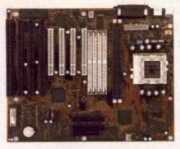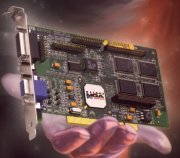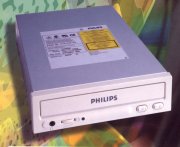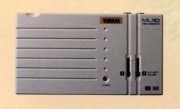Cliff's computer
For quite a while my computer at home consisted of a home built machine based around an Amstrad 9486i motherboard that I mounted in an old fruit box painted with white gloss paint!
More recently I decided to enter the 90's and gradually upgraded various components in the same way that a lot of people write to ask me about so I think that maybe my experiences may be of interest to others....

|
First I wanted a decent sound card because I'm quite
interested in electronic music (specifically playing keyboards). So I
wanted a soundcard that already had a decent complement of MIDI
instruments - particularly the pianos and organs. I also wanted a card
with RAM based wavetables that could be used to sample and then playback
as a new instrument. Finally I wanted a card that I could later upgrade
to an even better set of instruments. In the end I went for a Creative
Labs SoundBlaster AWE32. Unlike the more modern AWE64 this has (to my
mind) the advantage of using standard SIMMs so can easily have its
sample memory upgraded without paying through the nose for proprietary
memory modules. It also has a waveblaster daughterboard connector so the
awesome Yamaha DB50XG can easily be added when one wants to upgrade.
|

|
Having made do with a couple of 100MB and a 200MB drive all wired up and never having enough space I decided to junk all these and buy a single Seagate 6.4GB drive which (because of the Windows 95 limit) I partitioned into 3 main 2GB partitions and an extra bit giving me 4 logical drives. This had the added bonus that I could just copy the contents of my existing C:, D: and E: over onto the various logical drives and all the embedded drive letter references were still valid so there was no need to reinstall any software. Not only did the Seagate have astronomically better performance by virtue of much faster stepping rates but it is also an Ultra DMA 33 drive which means that when connected to the right motherboard and BIOS it can do up to 33MB/s data transfer. Naturally that meant that the next thing I need was a new motherborad and BIOS. |

|
I guess now the natural choice for anyone getting a new motherboard would be a PII board using the LX or BX chipset but when I upgraded in early '98 the old style Socket 7 boards were just coming to an end and were (and still are!) very good value. So I went for an Abit AX5 board and also got an Intel Pentium 233MMX processor. The Abit is a brilliant motherboard with its SoftMenu system that means that there are no jumpers to set and all that type of configuration is done in a BIOS menu that appears whatever the current settings might be and whatever CPU you happen to have fitted. The board is based on the Intel TX chipset which is the last, and best, version of the pre-PII chipsets. The board has loads of SIMM and DIMM sockets so you can still use the old 72pin SIMM memory from a previous board and then go on to fitting 168pin DIMMs for even more memory when the budget allows. Another advantage of the AX5 board is that the IDE interfaces are Ultra-DMA so with a fast drive like my Seagate one gets blistering performance. The board has a lot of the most recent PC97 features such as USB and ACPI which are just about the only reason why anyone would ever want to upgrade from Windows 95 to 98. The power features mean that it supports the soft-off feature of Win98 and will shutdown and then startup with all the programs exactly where you last left them so there's no need for a full shutdown anymore and fax/voicemail software will automatically wake up when the modem rings so finally you can do those features on a PC without having to leave it switched on all the time. |
|
|
In this day and age, when running Windows 95 (or, worse still, Windows NT) you just can't have enough memory so I upgraded to 48MB because memory is currently so ridiculously cheap. The only thing about TX motherboards is that they only cache the first 64MB so I probably won't bother going beyond 64MB but there isn't much point if I'm not going to be using Windows NT. |

|
After the motherboard and fast drive I then wanted better graphics performance and so wanted a PCI video card that did both 2D and 3D graphics at a reasonable rate of knots (mainly so I could play Flight Sim 98 at a decent rate with hardware acceleration). On the other hand I didn't want to spend buckets on the card so opted for the Matrox Mystique 220 which has a nice balance of cost and performance (though there are probably better cards available now). |

|
As almost everything these days comes on CD I figured a CD drive would be a good idea so went for a Philips 24X drive (this was before 32X were commonplace). Having used a 1X drive at work for several years the speed that even the 24X drive gives is an eye-opener! (Though 24X or 32X are a bit of a mis-nomer as the majority of such drives are actually accessed at 12X or 16X). |
| As the Abit motherboard is an ATX board (rather than the older style AT) I needed a new power supply and as they generally come with cases I pushed the boat out and got a new case (to replace my bannana box!) complete with ATX power supply. Almost without exception I have bought all the bits at Simply Computers as they are close, cheap and very give very good support service so I bought there generic ATX desktop case which is actually VERY stylish and being ATX has everything laid out in well thought out positions. | |

|
The other obvious piece of equipment that everyone needs if they are to get onto the internet is a modem. I read a number of reviews and the Diamond SupraExpress came out very highly in a lot of articles I read so I bought a 56e (and a 56i for my mum and dad). This modem is presently 56 Kflex but is flash upgradeable to V90 when the standard is ratified and ISP start to implement it but my current ISPs support the existing 56K standards and so the modem is already very useable but, like I'm sure all 56K modem users know, you very rarely connect at 56K but often 40+K is obtained which is a damned sight better than 28K8. |

|
Once I had all this new equipment up and working it was quite a while since I got the original AWE32 that started the whole upgrade process so I started to look at getting the 600+ voice Yamaha DB50XG to upgrade the AWE with just about the best set of MIDI voices you can get to stick in a computer. However I found that the external version of the XG card - the Yamaha MU10 - was only a few quid more and has the huge advantage that you don't need to cart the PC around to use it (though it helps!) - it can be used in isolation just connected direct to a MIDI synth with MIDI cables. When used with a PC it has the advantage that you can drive it via RS232 rather than tying up the MIDI interface on the AWE so you can effectively have two 16 channel MIDI ports rather than one. |

|
After the MU10 I wanted to get a decent colour printer so researched it widely trying to find all the reviews in magazines and on the internet that I could. The general consensu almost everywhere was that the Epson Stylus printers out perform and equivalent colour ink jets and the Epson Stylus 600 in particular, with its 1440dpi printer, and a number of recent price reductions looked like brilliant value so I bought one and can confirm that it is - it comes with a couple of pretty good programs on CD (just as well that I bought that CD drive!!). |

|
When one has a colour printer (and a web page!) the next obvious add-on to buy is a scanner so again I read as widely as possible on the subject and almost went for a BlackWidow 4830P (like my mum has) but I was so impatient that I couldn't wait for delivery so decided to pop over to Simply and buy one they had in stock. The very reasonably priced Umax 610P had received very good reviews (and a comparative review in Personal Computer World showed its actual quality outperforming some £200-300 scanners). |
|
So, there you have it, I have a Simply boxed 233MHz Pentium MMX with
48MB and 6.4GB disk, 24X CD, ATX motherboard, AWE32 sound, MU10 sound
enhancement, Epson Stylus 600 printer and Umax 610P scanner and (so far
- fingers crossed!) I have been very impressed with every bit of the
equipment.
I see that you can now buy a complete system including all the components I bought or better for about £800 (inc VAT) but gradually upgrading my machine as I did let me just buy the odd bit when I wanted and in the end I figure that the amount I spent was about: |
|
Computer Abit AX5 ATX motherboard £64 233MMX CPU+fan £92 48MB RAM (72 pin SIMMs) £70 Case/ATX PSU £55 Seagate 6.4GB hard drive £170 Philips 24X CD-ROM £45 2nd hand 15" Monitor £50 SUB TOTAL £546 Frivolous extras! AWE32 Soundcard £120 Yamaha MU10 £110 Diamond SupraExpress 56e modem £92 Epson Stylus 600 £156 Umax 610P scanner £67 SUB TOTAL £545 TOTAL £1091